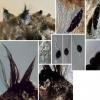
15-12-2025 15:54
 Johan Boonefaes
Johan Boonefaes
Unknown anamorph found on the ground in coastal sa

15-12-2025 15:48
 Danny Newman
Danny Newman
Melanospora cf. lagenaria on old, rotting, fallen

15-12-2025 07:05
 Danny Newman
Danny Newman
Pseudosclerococcum golindoi (det: Zotto)near Cosb

15-12-2025 11:49
 Danny Newman
Danny Newman
ITS sequences from the following two collections B

15-12-2025 07:09
 Danny Newman
Danny Newman
indet. Rutstroemiaceae sp. on unk. fallen leavesMc

15-12-2025 12:34
 Danny Newman
Danny Newman
indet. Rhytismataceae on oak leafnear Purchase Roa

09-12-2025 12:06
 Andgelo Mombert
Andgelo Mombert
Bonjour,Je recherche l'article concernant Hypobryo

12-12-2025 18:39
Mirek GrycHello everyone.Macrofeatures similar to Mollisia b
 This is yet another Podospora which has developed on a collection of rabbit dung (along with P. (Schizothecium) tetraspora, P. fimiseda and P. pleiospora).
This is yet another Podospora which has developed on a collection of rabbit dung (along with P. (Schizothecium) tetraspora, P. fimiseda and P. pleiospora).It seems to sit uncomfortably between P. setosa and P. curvicolla.
For the former are characters like the shape of the asci (clavate, not saccate), no asci with 256 spores and the gelatinous appendages which are persistent on the mature spores and do not disappear in water mounts.
But the spores seem small for P. setosa and would fit better in P. curvicolla - they measure 16.4-17.3 x 10.4-11.7µm; also in some cases the hairs could be considered 'agglutinated'. I know there are ASCOFrance members with lots of experience of these coprophiles, and would again be grateful for assistance.
Cordialement
Chris

It is sometimes difficult to separate these two species, but the size of the spores and "agglutined" hairs closer to curvicolla.
It is important to measure a large number of spores to have a mean, especially since it is sometimes difficult to count the number of spores within the ascus. I also picked up some copies of P.curvicolla with little hairs "agglutined".
Michel.
